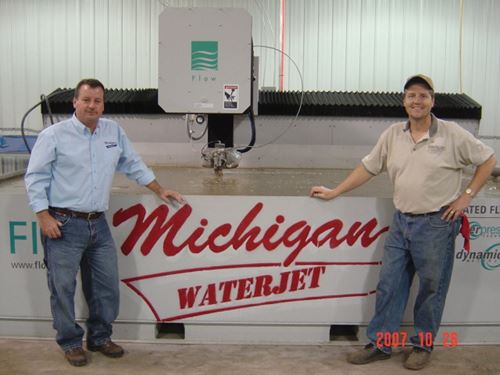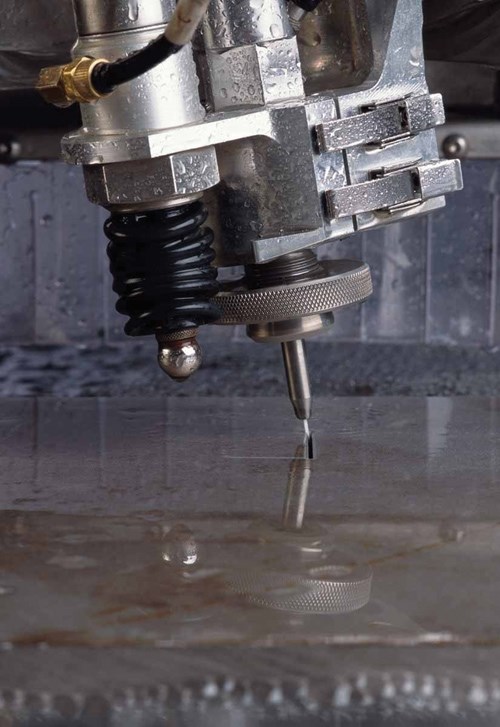Waterjets Increase Pressure On The Competition
Featuring high-pressure pumps and Dynamic Cutting technology, waterjets from Flow International help this shop maintain its competitive edge.
It might be intuitive to think of accuracy and speed as a manufacturing tradeoff—increasing one might compromise the other. According to one Albion, Michigan-based manufacturer, however, that’s not the case with waterjet machines from Flow International (Kent, Washington). These models’ high-pressure streams and ability to offset the natural taper that often occurs with waterjet cutting have enabled the shop to regularly outclass its competition despite having only a few years in business, says co-founder Jack Bates.
Mr. Bates and Landon Clawson launched Michigan Waterjet in 2007 after recognizing an underserved niche for waterjet service in the aerospace and military markets. One of waterjet machining’s primary advantages is that the process produces no heat. In contrast, heat generated by conventional processes can either distort parts entirely or harden the workpiece material to the point where tool life suffers and additional machining work is more difficult, Mr. Bates explains. Waterjet also provides the flexibility to cut materials ranging from heavy steel to aluminum, rubber, glass and ceramics with relative ease in a single step.
However, deciding to specialize in waterjet machining was an easy proposition compared to deciding what specific models would best facilitate timely delivery of high-quality, precision parts. Mr. Clawson, who has a solid background in waterjet cutting technology, had heard buzz in the industry about pumps from Flow International that delivered 87,000 psi of water pressure. After spending a great deal of time comparing this technology to other options, Mr. Clawson and Mr. Bates were sold. "I literally researched 87,000-psi waterjet cutting 24 hours a day, 7 days a week, for months," Mr. Bates says. "In the end, we were impressed, and we implemented this technology into our business without hesitation."
The shop now contains two Flow machines. Complementing the waterjets are two laser cutting machines from Mitsubishi Laser (Wood Dale, Illinois), which are used for jobs in which heat is not a concern. These four machines occupy very little of the available 20,000 square feet of floor space, leaving the shop plenty of room to expand as business grows. Considering how the high-pressure pumps and other waterjet features have impacted the shop’s productivity already, future expansion is not an unlikely
proposition.
According to Flow, the industry standard for waterjet pump pressure is 60,000 psi. Cutting at 87,000 psi raises power density by 75 percent compared to the standard. Increased power density translates to a faster stream that transfers more kinetic energy to the abrasive particles within it. In addition to improving production capacity, the fact that the accelerated stream imparts more cutting power into each abrasive particle reduces costs. That’s because less abrasive is needed to remove the required amount of material on any given job.
Michigan Waterjet didn’t stop there, however. Although its machines shipped with 87,000-psi pumps as a standard feature, the shop has since incorporated one of Flow’s more recent developments: the HyperPressure system, which provides 94,000 psi. HyperPressure is not just a pump, but a complete system incorporating components such as a quick-acting on/off valve, an advanced cutting head, custom plumbing materials and more, all designed to increase cutting power and reduce operating costs.
To avoid unnecessary fatigue on the machine, the shop doesn’t always use the highest pressure setting, Mr. Bates says. For particularly time-sensitive work, however, that capability is invaluable. "Cut quality is always our No. 1 concern, and all waterjets are capable of quality cuts—you can cut with a 55,000-psi machine and get the same results that I can with 94,000 psi. The advantage of high pressure is that it allows us to do the job faster," he explains. "With today’s ‘just in time’ philosophy, that has proven to be really beneficial."
While high-pressure streams enable faster material removal at the point of the cut, the shop also relies on its ability to feed the stream into the workpiece quickly without compromising part quality. This is facilitated by another technology that complements the high-pressure pumps: Flow’s Dynamic Waterjet with Active Tolerance Control. This system compensates for the natural stream lag associated with conventional waterjets to prevent unwanted edge tapers.
Mr. Bates explains that unwanted tapers are a result of the nature of waterjet cutting, in which the "cutting tool" is a pressurized stream of water imbued with abrasive particles. He compares the effect to spraying a garden hose on the ground along a straight line—
the actual point at which the stream hits the ground is always slightly behind the head of the hose. On a waterjet machine, this effect can cause edge tapers that pose problems for part quality, especially when negotiating corners. Naturally, the faster the feed, the more pronounced the taper, so a typical solution is to slow feed rates.
That’s not necessary with dynamic cutting, which uses a motion control system incorporating mathematical cutting models that control a small, articulated wrist attached to the cutting head. This wrist enables the cutting head to tilt in any direction to compensate for the natural stream lag and taper that occurs with waterjet machining.
The FlowMaster control system performs all the mathematical calculations required for these taper offsets behind the scenes. The operator simply enters material type, thickness, desired edge finish and other basic cutting parameters, and the control does the rest.
"The use of Dynamic Waterjet cutting in combination with the 87,000 psi is key in eliminating taper and delivering a finished product to customers in a timely manner," Mr. Bates concludes. "We are often compared by our customers in quoting. In some cases, we are cutting 50 percent faster than those with 50,000- to 60,000-psi machines."
Related Content
Buying a Lathe: The Basics
Lathes represent some of the oldest machining technology, but it’s still helpful to remember the basics when considering the purchase of a new turning machine.
Read MoreThreading On A Lathe
The right choices in tooling and technique can optimize the thread turning process.
Read MoreChoosing Your Carbide Grade: A Guide
Without an international standard for designating carbide grades or application ranges, users must rely on relative judgments and background knowledge for success.
Read MoreUnderstanding Swiss-Type Machining
Once seen as a specialty machine tool, the CNC Swiss-type is increasingly being used in shops that are full of more conventional CNC machines. For the newcomer to Swiss-type machining, here is what the learning curve is like.
Read MoreRead Next
3 Mistakes That Cause CNC Programs to Fail
Despite enhancements to manufacturing technology, there are still issues today that can cause programs to fail. These failures can cause lost time, scrapped parts, damaged machines and even injured operators.
Read MoreObscure CNC Features That Can Help (or Hurt) You
You cannot begin to take advantage of an available feature if you do not know it exists. Conversely, you will not know how to avoid CNC features that may be detrimental to your process.
Read MoreThe Cut Scene: The Finer Details of Large-Format Machining
Small details and features can have an outsized impact on large parts, such as Barbco’s collapsible utility drill head.
Read More


















.png;maxWidth=300;quality=90)








